Abstract
The charts of all patients with common bile duct (CBD) stones admitted to Virginia Mason Medical Center between January 1, 1981 and July 31, 1986 were reviewed to define current methods of management and results of operative versus endoscopic therapy. Two hundred thirty-seven patients with CBD stones were treated. One hundred thirty patients had intact gallbladders. Of these patients, 76 (59%) underwent cholecystectomy and common bile duct exploration (CBDE) while 54 (41%) underwent endoscopic papillotomy (EP) only. Of the 107 patients admitted with recurrent stones after cholecystectomy, all but five were treated with EP. The overall mortality rate was 3.0%. Complications, success, and death rates were all similar for CBDE and EP, but the complications of EP were often serious and directly related to the procedure (GI hemorrhage, 6; duodenal perforation, 5; biliary sepsis, 4; pancreatitis, 1). Patients undergoing EP required significantly shorter hospitalization than those undergoing CBDE. Multivariate analysis showed that age greater than 70 years, technical failure, and complications increased the risk of death, regardless of procedure performed. Twenty-one per cent of those undergoing EP with gallbladders intact eventually required cholecystectomy. The conclusion is that the results of EP and CBDE are similar, and the use of EP has not reduced the mortality rates of this disease.
Full text
PDF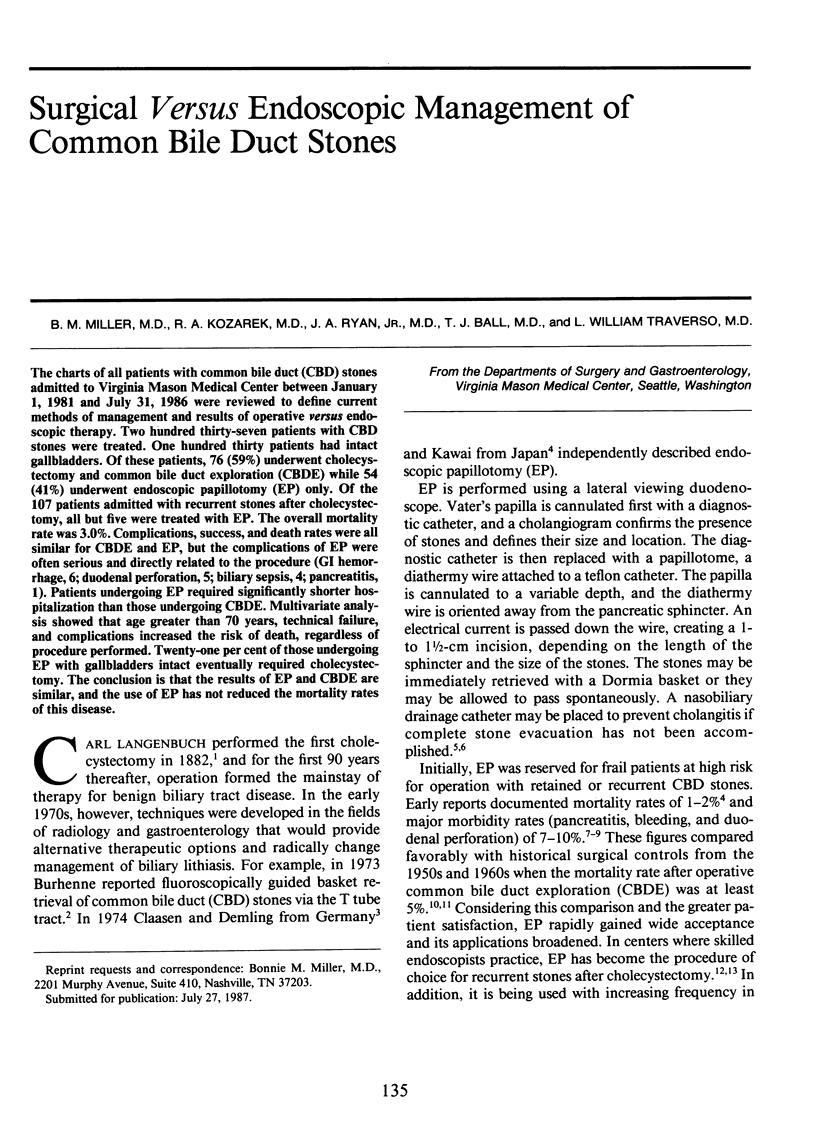
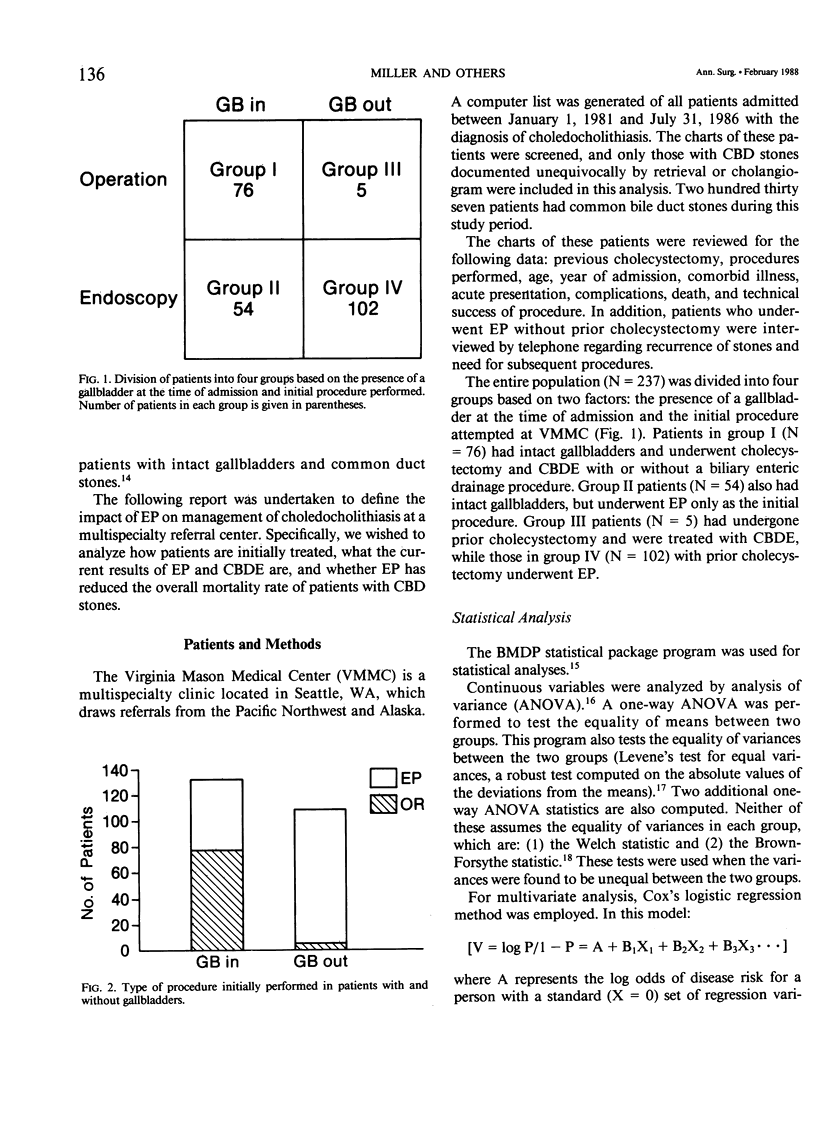

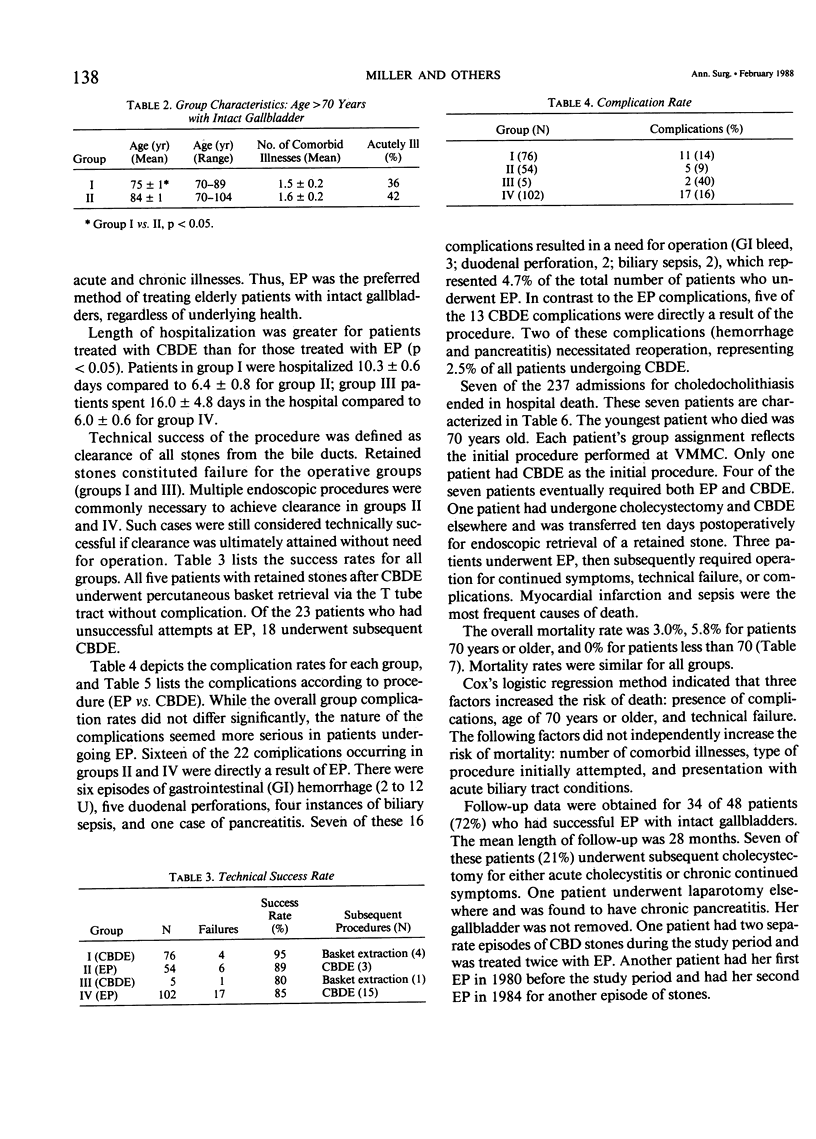

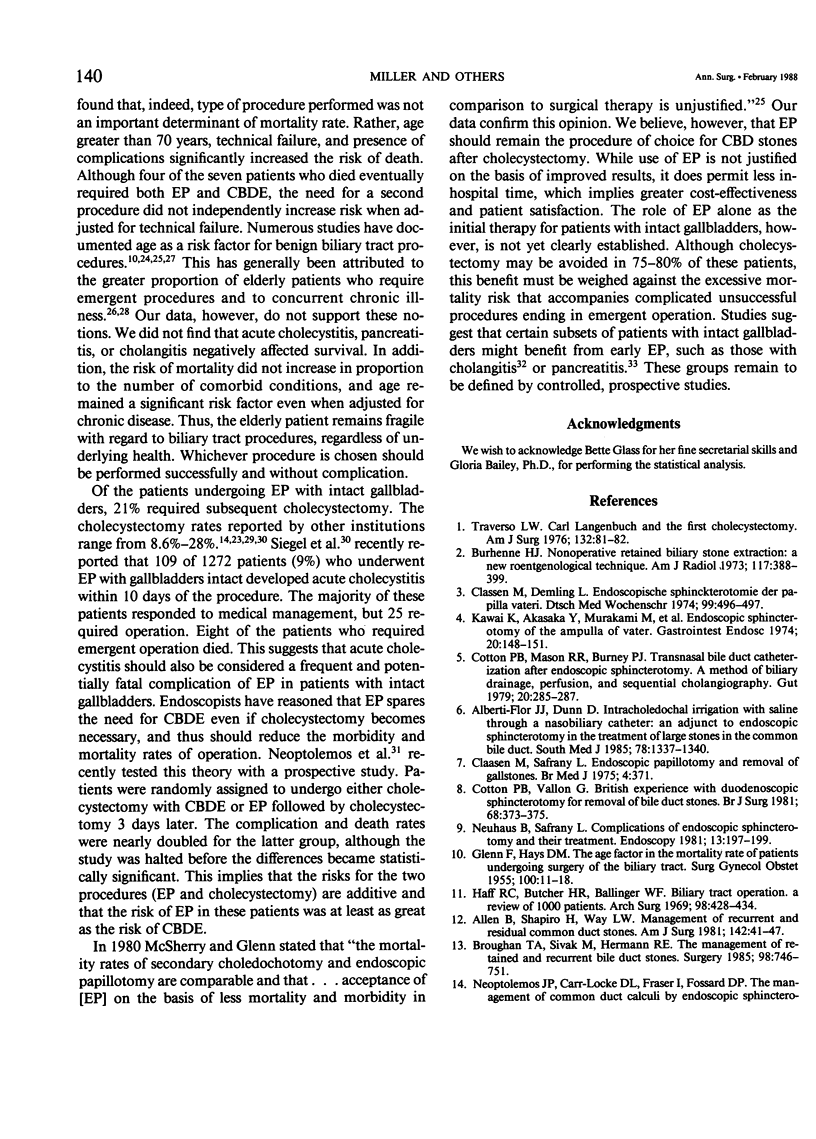
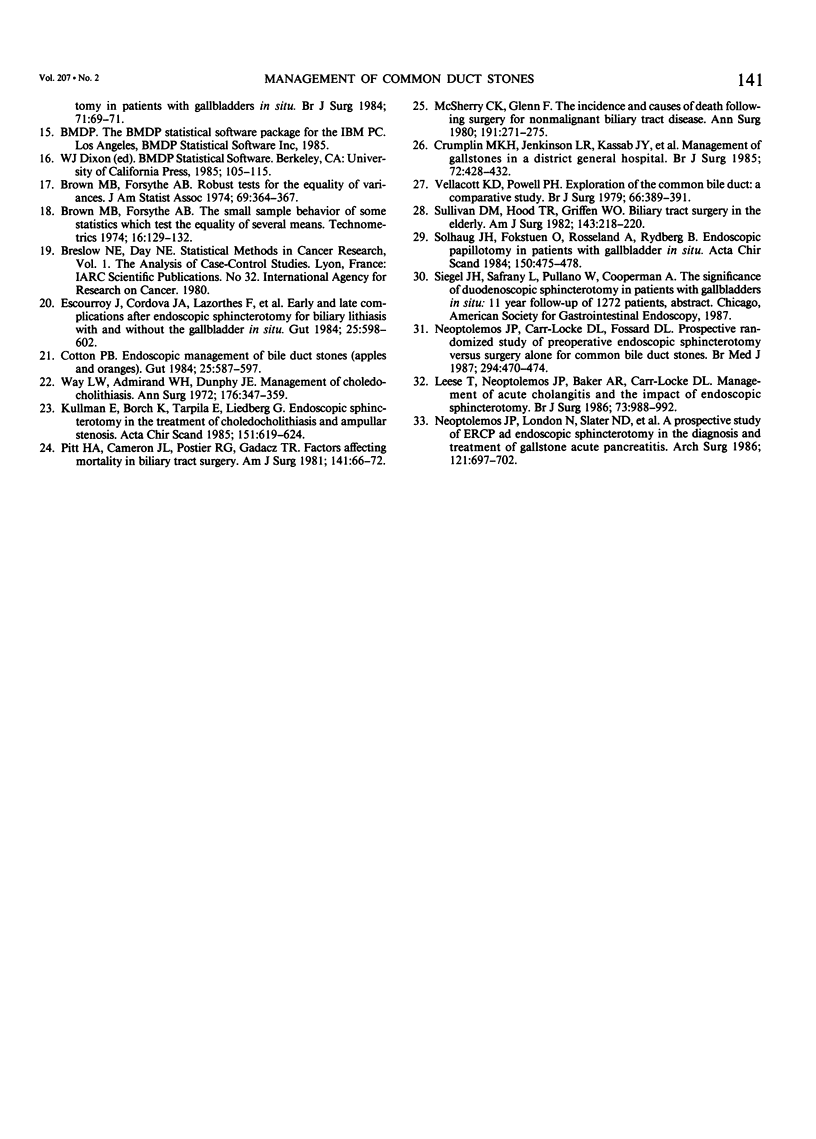
Selected References
These references are in PubMed. This may not be the complete list of references from this article.
- Alberti-Flor J. J., Dunn G. D. Intracholedochal irrigation with saline through a nasobiliary catheter: an adjunct to endoscopic sphincterotomy in the treatment of large stones in the common bile duct. South Med J. 1985 Nov;78(11):1337–1340. [PubMed] [Google Scholar]
- Allen B., Shapiro H., Way L. W. Management of recurrent and residual common duct stones. Am J Surg. 1981 Jul;142(1):41–47. doi: 10.1016/s0002-9610(81)80009-8. [DOI] [PubMed] [Google Scholar]
- Broughan T. A., Sivak M. V., Hermann R. E. The management of retained and recurrent bile duct stones. Surgery. 1985 Oct;98(4):746–751. [PubMed] [Google Scholar]
- Burhenne H. J. Nonoperative retained biliary tract stone extraction. A new roentgenologic technique. Am J Roentgenol Radium Ther Nucl Med. 1973 Feb;117(2):388–399. doi: 10.2214/ajr.117.2.388. [DOI] [PubMed] [Google Scholar]
- Classen M., Demling L. Endoskopische Sphinkterotomie der Papilla Vateri und Steinextraktion aus dem Ductus choledochus. Dtsch Med Wochenschr. 1974 Mar 15;99(11):496–497. doi: 10.1055/s-0028-1107790. [DOI] [PubMed] [Google Scholar]
- Cotton P. B., Burney P. G., Mason R. R. Transnasal bile duct catheterisation after endoscopic sphincterotomy: method for biliary drainage, perfusion, and sequential cholangiography. Gut. 1979 Apr;20(4):285–287. doi: 10.1136/gut.20.4.285. [DOI] [PMC free article] [PubMed] [Google Scholar]
- Cotton P. B. Endoscopic management of bile duct stones; (apples and oranges). Gut. 1984 Jun;25(6):587–597. doi: 10.1136/gut.25.6.587. [DOI] [PMC free article] [PubMed] [Google Scholar]
- Cotton P. B., Vallon A. G. British experience with duodenoscopic sphincterotomy for removal of bile duct stones. Br J Surg. 1981 Jun;68(6):373–375. doi: 10.1002/bjs.1800680602. [DOI] [PubMed] [Google Scholar]
- Crumplin M. K., Jenkinson L. R., Kassab J. Y., Whitaker C. M., Al-Boutiahi F. H. Management of gallstones in a district general hospital. Br J Surg. 1985 Jun;72(6):428–432. doi: 10.1002/bjs.1800720605. [DOI] [PubMed] [Google Scholar]
- Escourrou J., Cordova J. A., Lazorthes F., Frexinos J., Ribet A. Early and late complications after endoscopic sphincterotomy for biliary lithiasis with and without the gall bladder 'in situ'. Gut. 1984 Jun;25(6):598–602. doi: 10.1136/gut.25.6.598. [DOI] [PMC free article] [PubMed] [Google Scholar]
- GLENN F., HAYS D. M. The age factor in the mortality rate of patients undergoing surgery of the biliary tract. Surg Gynecol Obstet. 1955 Jan;100(1):11–18. [PubMed] [Google Scholar]
- Haff R. C., Butcher H. R., Jr, Ballinger W. F., 2nd Biliary tract operations. A review of 1,000 patients. Arch Surg. 1969 Apr;98(4):428–434. doi: 10.1001/archsurg.1969.01340100060006. [DOI] [PubMed] [Google Scholar]
- Kawai K., Akasaka Y., Murakami K., Tada M., Koli Y. Endoscopic sphincterotomy of the ampulla of Vater. Gastrointest Endosc. 1974 May;20(4):148–151. doi: 10.1016/s0016-5107(74)73914-1. [DOI] [PubMed] [Google Scholar]
- Kullman E., Borch K., Tarpila E., Liedberg G. Endoscopic sphincterotomy in the treatment of choledocholithiasis and ampullar stenosis. Experience with 202 patients. Acta Chir Scand. 1985;151(7):619–624. [PubMed] [Google Scholar]
- Leese T., Neoptolemos J. P., Baker A. R., Carr-Locke D. L. Management of acute cholangitis and the impact of endoscopic sphincterotomy. Br J Surg. 1986 Dec;73(12):988–992. doi: 10.1002/bjs.1800731214. [DOI] [PubMed] [Google Scholar]
- McSherry C. K., Glenn F. The incidence and causes of death following surgery for nonmalignant biliary tract disease. Ann Surg. 1980 Mar;191(3):271–275. doi: 10.1097/00000658-198003000-00003. [DOI] [PMC free article] [PubMed] [Google Scholar]
- Neoptolemos J. P., Carr-Locke D. L., Fossard D. P. Prospective randomised study of preoperative endoscopic sphincterotomy versus surgery alone for common bile duct stones. Br Med J (Clin Res Ed) 1987 Feb 21;294(6570):470–474. doi: 10.1136/bmj.294.6570.470. [DOI] [PMC free article] [PubMed] [Google Scholar]
- Neoptolemos J. P., Carr-Locke D. L., Fraser I., Fossard D. P. The management of common bile duct calculi by endoscopic sphincterotomy in patients with gallbladders in situ. Br J Surg. 1984 Jan;71(1):69–71. doi: 10.1002/bjs.1800710123. [DOI] [PubMed] [Google Scholar]
- Neoptolemos J. P., London N., Slater N. D., Carr-Locke D. L., Fossard D. P., Moosa A. R. A prospective study of ERCP and endoscopic sphincterotomy in the diagnosis and treatment of gallstone acute pancreatitis. A rational and safe approach to management. Arch Surg. 1986 Jun;121(6):697–702. doi: 10.1001/archsurg.1986.01400060093013. [DOI] [PubMed] [Google Scholar]
- Nuehaus B., Safrany L. Complications of endoscopic sphinecterotomy and their treatment. Endoscopy. 1981 Sep;13(5):197–199. doi: 10.1055/s-2007-1021682. [DOI] [PubMed] [Google Scholar]
- Pitt H. A., Cameron J. L., Postier R. G., Gadacz T. R. Factors affecting mortality in biliary tract surgery. Am J Surg. 1981 Jan;141(1):66–72. doi: 10.1016/0002-9610(81)90014-3. [DOI] [PubMed] [Google Scholar]
- Solhaug J. H., Fokstuen O., Rosseland A., Rydberg B. Endoscopic papillotomy in patients with gallbladder in situ. Is subsequent cholecystectomy necessary? Acta Chir Scand. 1984;150(6):475–478. [PubMed] [Google Scholar]
- Sullivan D. M., Hood T. R., Griffen W. O., Jr Biliary tract surgery in the elderly. Am J Surg. 1982 Feb;143(2):218–220. doi: 10.1016/0002-9610(82)90072-1. [DOI] [PubMed] [Google Scholar]
- Traverso L. W. Carl Langenbuch and the first cholecystectomy. Am J Surg. 1976 Jul;132(1):81–82. doi: 10.1016/0002-9610(76)90295-6. [DOI] [PubMed] [Google Scholar]
- Vellacott K. D., Powell P. H. Exploration of the common bile duct: a comparative study. Br J Surg. 1979 Jun;66(6):389–391. doi: 10.1002/bjs.1800660605. [DOI] [PubMed] [Google Scholar]
- Way L. W., Admirand W. H., Dunphy J. E. Management of choledocholithiasis. Ann Surg. 1972 Sep;176(3):347–359. doi: 10.1097/00000658-197209000-00011. [DOI] [PMC free article] [PubMed] [Google Scholar]


